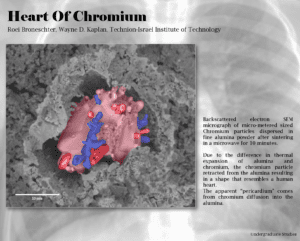ACerS Basic Science Division
Our Mission
The Basic Science Division of The American Ceramic Society is dedicated to the development of ceramic science underlying present and future applications of ceramics. The Basic Science Division fosters the scientific and technological foundations of ceramic science, identifying new areas in, and fields of, ceramic science critical to our current and future members.

Roei Broneschter

2022 Roland B. Snow Award
Best in Show winner
Title: “Heart of Chromium”
Roei Broneschter, Wayne D. Kaplan; Technion-Israel Institute of Technology
Electronic Materials & Applications 2023
January 17 - 20, 2023
Meeting Details
A curated selection of articles published in the The American Ceramic Society journals.
View our 2023-2024 BSD Officers.
Recognizing excellence in ceramic and glass science.
View the Division’s annual reports and rules governing the division.
The American Ceramic Society values and seeks diverse and inclusive participation within the field of ceramic science and engineering.
ACerS strives to promote involvement and access to leadership opportunity regardless of race, ethnicity, gender, religion, age, sexual orientation, nationality, disability, appearance, geographic location, career path or academic level.
About BSD
Learn how BSD can help your research and career. Download and share the BSD flyer summarizing the Division’s benefits, mission and focused meetings.
The Materialism Podcast
In 2020, the division provided a sponsorship to help produce the University of Utah's materials science podcasts co-created by Professor Taylor Sparks, student moderator, Andrew Falkowski, and student audio technician Jared Duffy. The Materialism Podcast is a podcast dedicated to exploring the past, present, and future of materials science. Click on the icon below to listen to one of the many interesting episodes.
Research
The Basic Science Division solicits technical topic areas of interest to our members and the future of ceramics. BSD researchers study fundamental science and processes such as:
materials and process modeling | measurements and standards | environmentally friendly processing | combinatorial methods | colloids and interfacial chemistry | fuel cells and batteries | microporous materials | nanotechnologies | ceramics and biology | biomedical materials | electronic structure of ceramics | polishing and tribology | materials for wireless communication | ceramics in optical communication | lightweight composites |electrochemical sensors and catalysts | solid free-form fabrication |novel synthesis and processing | multifunctional materials | ceramic coatings | thin films | joining | interfaces | sintering | preceramic polymers | thermal protection materials | ceramic armor and window materials | layered materials | high-temperature composites | membranes and filtration | photovoltaics | functionally graded materials | photonic crystals | powder mechanics | texture


